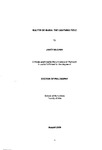WALTER DE MARIA: THE LIGHTNING FIELD
| dc.contributor.author | McCANN, JANET | |
| dc.contributor.other | Faculty of Arts, Humanities and Business | en_US |
| dc.date.accessioned | 2013-10-29T11:49:18Z | |
| dc.date.available | 2013-10-29T11:49:18Z | |
| dc.date.issued | 2009 | |
| dc.identifier | NOT AVAILABLE | en_US |
| dc.identifier.uri | http://hdl.handle.net/10026.1/2435 | |
| dc.description.abstract |
Walter De Maria (b.1935) is best known for The Lightning Field, a large-scale, remote outdoor work constructed in New Mexico, USA, and completed in 1977. Both De Maria and The Lightning Field have largely been critiqued solely within the art-historical framework of 'Land Art'. This thesis argues that such a framework has been too homogeneous and too narrow in its scope to do justice to the true complexities either of the artist's practice or of the visitor's experience of The Lightning Field, which involves considerably more than the dramatic spectacle of lightning. It proposes that De Maria's wide-ranging artistic career during the 1960s- in Minimalism and in 'Happenings', in proto-Fluxus and as a musician- provides a crucial context for an understanding of The Lightning Field. In particular, it argues that De Maria's engagement in music is of far greater significance than has so far been recognised, and that an exploration of the work of experimental composers John Cage, La Monte Young, and Steve Reich facilitates a richer understanding of many aspects of the visitor's experience of The Lightning Field. The thesis reviews the literature on 'Land Art' (Chapter Two), before going on to provide a much more detailed account of De Maria's career- in music as well as in art - prior to the making of The Lightning Field, in order to give some flavour of the true breadth of his interests and friendships (Chapter Three). It also provides a thorough reassessment of what has mistakenly been construed as De Maria's critical 'silence' (Chapter Four). After giving brief details of The Lightning Field's construction and visiting arrangements (Chapter Five), the next four chapters (Chapters Six to Nine) explore a number of hitherto neglected aspects of the visitor's experience of the work - driving, walking, watching, slowing down, listening, imagining - especially in relation to spatiotemporal concerns in experimental music. De Maria's aesthetic has been remarkably consistent throughout his career, despite the variety of means used to explore it, and the concluding chapter of this thesis (Chapter Ten) examines some of De Maria's more recent works in order to demonstrate his continuing concern for the complex dynamic between art, audience, and environment. | en_US |
| dc.language.iso | en | en_US |
| dc.publisher | University of Plymouth | en_US |
| dc.title | WALTER DE MARIA: THE LIGHTNING FIELD | en_US |
| dc.type | Thesis | |
| plymouth.version | Full version | en_US |
| dc.identifier.doi | http://dx.doi.org/10.24382/4894 |
Files in this item
This item appears in the following Collection(s)
-
01 Research Theses Main Collection
Research Theses Main


